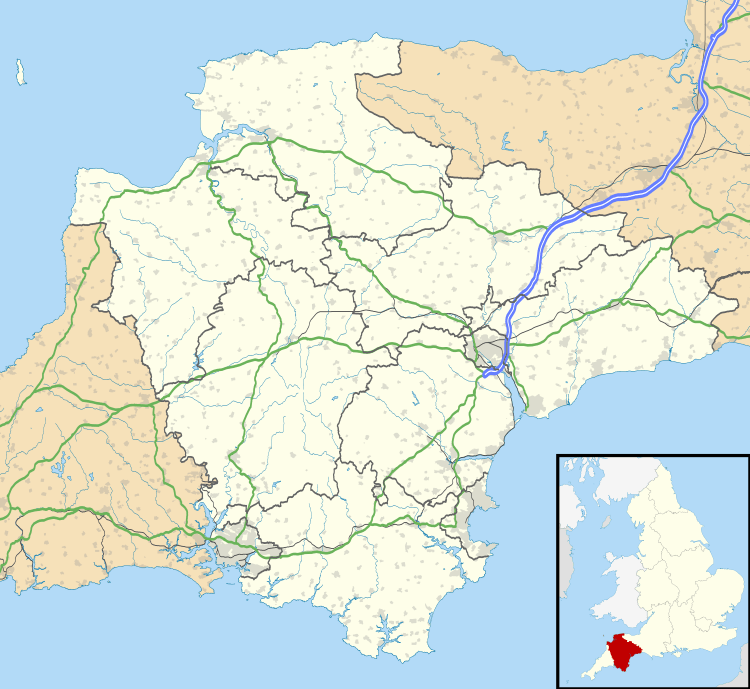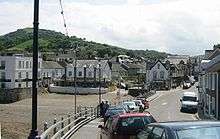Combe Martin
| Combe Martin | |
 St. Peter ad Vincula parish church |
|
 Combe Martin |
|
| Population | 2,687 (2011 census)[1] |
|---|---|
| OS grid reference | SS5846 |
| Civil parish | Combe Martin |
| District | North Devon |
| Shire county | Devon |
| Region | South West |
| Country | England |
| Sovereign state | United Kingdom |
| Post town | Ilfracombe |
| Postcode district | EX34 |
| Dialling code | 01271 |
| Police | Devon and Cornwall |
| Fire | Devon and Somerset |
| Ambulance | South Western |
| EU Parliament | South West England |
| UK Parliament | North Devon |
| Website | Combe Martin Parish Council |
Coordinates: 51°11′N 4°01′W / 51.19°N 04.02°W
Combe Martin is a village, civil parish and former manor on the North Devon coast about 4 miles (6.4 km) east of Ilfracombe. It is a small seaside resort with a sheltered cove on the north-west edge of the Exmoor National Park. Due to the narrowness of the valley, the village consists principally of one single long street which runs 2 miles (3.2 km) between the valley head and the sea. An electoral ward with the village name exists. The ward population at the 2011 census was 3,941.[2]
History
Evidence of Iron Age occupation includes the nearby Newberry Castle fort. The toponym "Combe" is derived from Old English cumb meaning "wooded valley". It derives ultimately from the same Brythonic source as the Welsh cwm, also of the same meaning. The name was recorded as Comer in 1128. The 'Martin' suffix on the place name is from the name of the FitzMartin family, feudal barons of Barnstaple, from which large barony the manor of Combe was held. The FitzMartins held the barony following the marriage of Nicholas FitzMartin (d.1260) to Maud de Tracy, heiress of the barony of Barnstaple, until the death of his grandson William II FitzMartin in 1326 who left his two sisters co-heiresses.[3]
There are several disused silver mines on the eastern ridge and evidence of tunnels can still be seen, as well as the remains of a wheelhouse used to lift ore from the mine. There are items in the Crown Jewels made from Combe Martin silver and a large part of the war expenses of Edward the Third and Henry the Fifth were paid for by the sale of silver mined here.
The unusual dedication of the Church of England parish church to St. Peter ad Vincula ("St. Peter in Chains") is derived from the ancient Basilica of San Pietro in Vincoli in Rome.
One of the village's unusual features is the Pack o' Cards public house built around 1700 by George Ley. Reputed to have been funded by his gambling successes, it originally had 52 windows, 13 rooms and four floors (matching the numbers from a pack of cards).
Village street
It is believed that the street is the longest village street in England, but this is actually a myth. It was recently measured at around a mile and a half long. The actual longest street is Stewkley, Buckinghamshire. The myth has several possible origins:
- Combe Martin has the Guinness world record for the world's longest street party, this can easily be confused as longest village street (or, indeed, the longest high street).
- Many people measure Combe Martin from one "you are entering Combe Martin" sign to the other. One of the signs is placed an unusually long way from the village (approx 1 mile and one half) which can lead to confusion.
- Combe Martin has several very active pubs. There is a saying in Combe Martin that "At the George and Dragon they talk about my sprained thumb, at the Dolphin they talk about my broken leg." Basically saying is that at the pubs at Combe Martin stories really have a chance to be exaggerated and maybe such is the case here.
Annual events
At one time there were nine pubs: The Castle, The Dolphin, the Fo'c'stle, the George and Dragon, the Lion Inn, The London Inn, The Marine, the Pack O' Cards and the Top George. As part of the annual Carnival celebrations, there was a wheelbarrow race over the length of the village, competitors having to stop at each pub and consume a glass of beer before continuing. In 2008 the wheelbarrow race was replaced by a Fun Run and alcohol free wheelbarrow parade. The wheelbarrow race was reinstated in 2009.
The annual procession "The Hunting of the Earl of Rone" features the rare hobby horse of England and a character called the Earl of Rone. The Hunting of the Earl of Rone takes place over a weekend, finishing with a two-mile procession along the main street, featuring, as well as the 'obby 'oss and Earl of Rone, a Fool, "Grenadiers", drummers and music, a donkey, and hundreds of dancers in festive dress.
The custom was banned in 1837 (due to 'licentiousness and drunken behaviour') as well as the death of a drunken parishioner falling off of a wall during the celebrations. The Rone custom was reconstructed in 1970. Legend has it that the Earl of Tyrone fled Ireland in 1607 and was shipwrecked at Rapparee Beach, in Ilfracombe harbour, to the west of the village. In fact, he made it to the continent. It is an interesting and noisy event which takes place over the Spring Bank Holiday weekend each year.
Local attractions

Just to the east of Combe Martin Bay are the Hangman hills, the Hangman cliffs are made up of Little Hangman and the Great Hangman. The Great Hangman is a hog-backed hill of 1043 ft with a cliff-face of 820 ft, making it the highest cliff in southern Britain, and can be reached by following the South West Coast Path which runs through the village. Combe Martin lies within the North Devon Area of Outstanding Natural Beauty.
A regular farmers' market is held at the village hall.
The Wildlife and Dinosaur Park is similar to a normal wildlife park, containing animals such as wallabies, free-roaming macaws, wolves and lions, but there are also models and animatronic dinosaurs. The models are in their own area, Domain of the Dinosaurs, whilst the animatronics (T. rex, Dilophosaurus, Megalosaurus and Velociraptor) have an enclosure in the main area of the park. There is also a Dinosaur Museum with a fossilised skeleton and egg nest of some dinosaurs. Other attractions include a train ride with a massive flood of water, shows with sealions and wolves, a light show and a mock Egyptian tomb with hieroglyphics and mummies.
Notable residents
- Clara Larter (1847–1936), botanist[4]
See also
References
- ↑ "Parish population 2011". Retrieved 21 February 2015.
- ↑ "Ward population 2011". Retrieved 21 February 2015.
- ↑ Sanders, English Baronies, Oxford, 1960, p.104, Barnstaple
- ↑ Fraser, G.T. (1936–1937). "Obituaries: Clara Ethelinda Larter". Proc. Linnean Soc. Linnean Society of London. 149 (4): 200–202.
External links
| Wikimedia Commons has media related to Combe Martin. |
- Combe Martin at DMOZ
